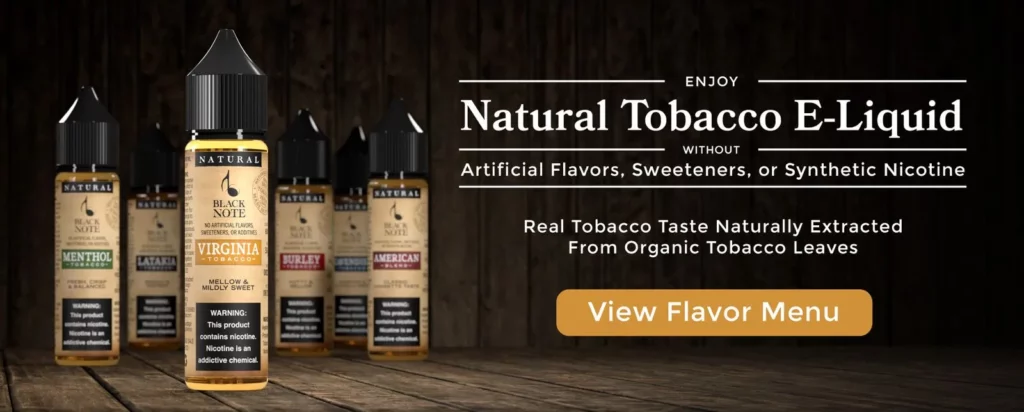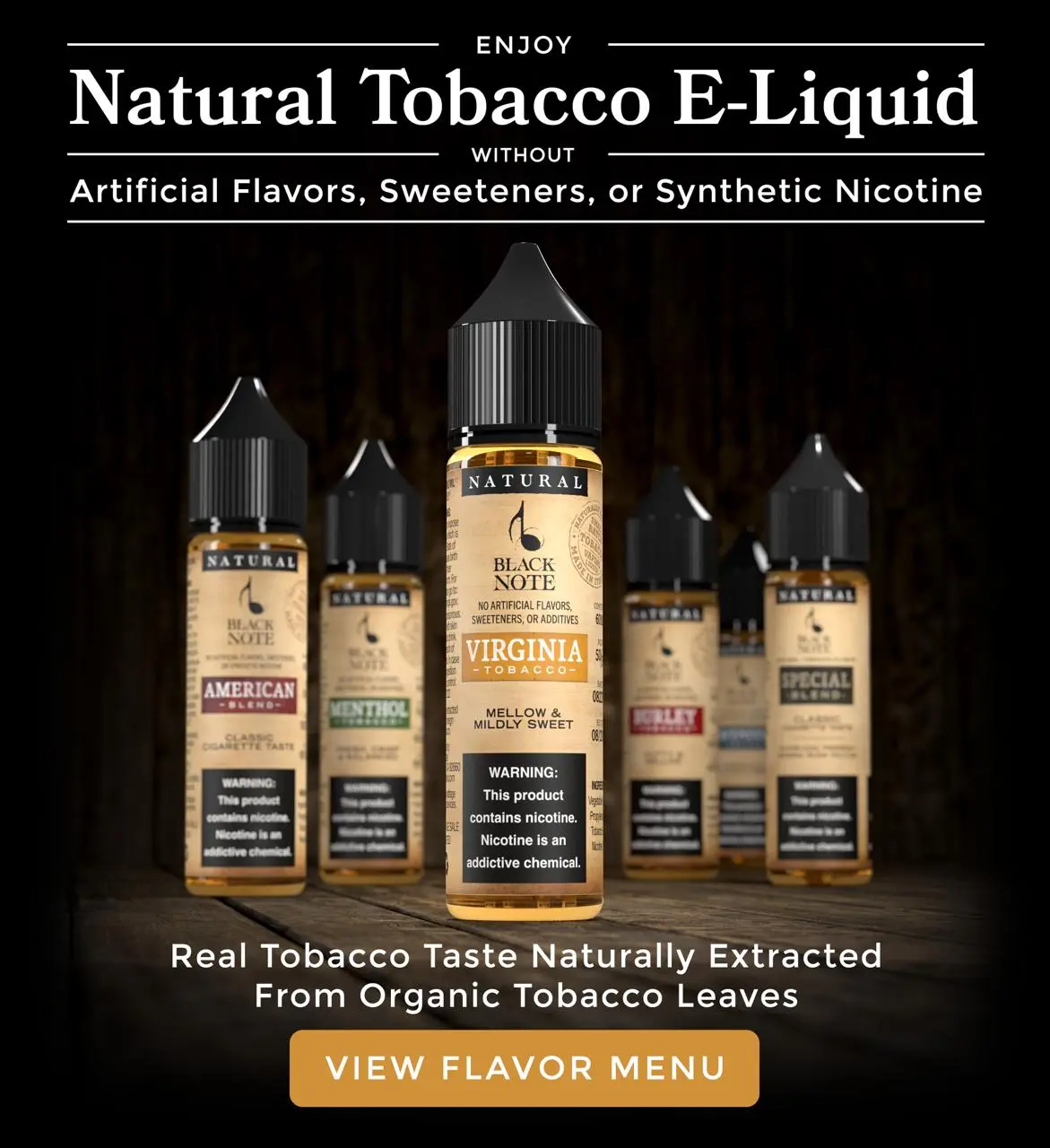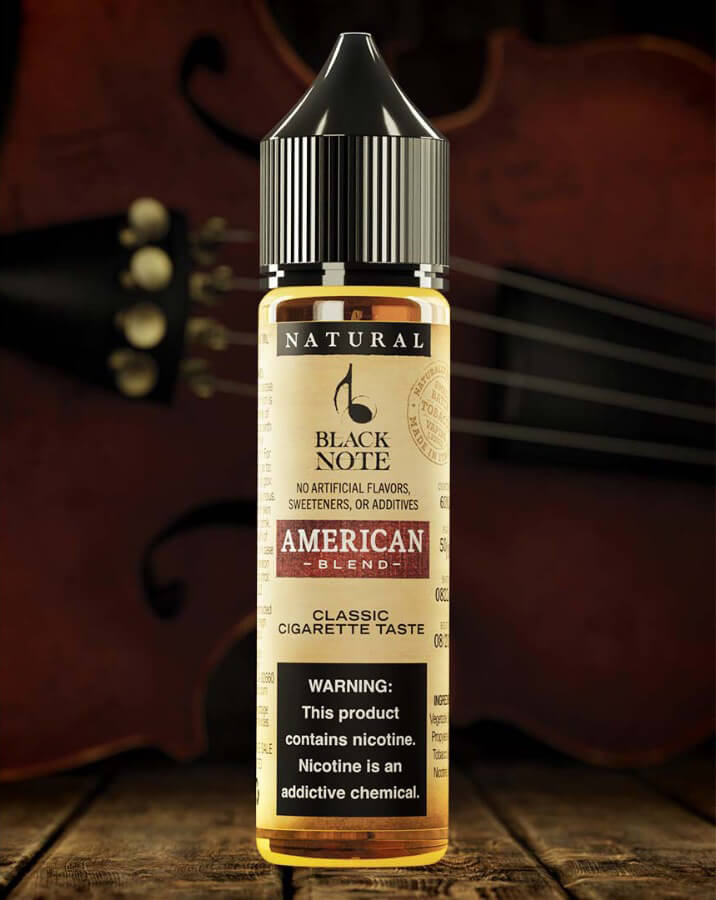Table of Contents
- Finding Smoke-Free Solutions for Adult Smokers
- Difference between Nicotine & Tobacco
- Important Warning – Zero Percent Nicotine Products
- Understanding Nicotine’s Journey Through Your Body
- The Reality of Nicotine Addiction and Quitting Smoking
- Nicotine’s Role in Smoke-Free Alternatives
- Scientifically Proven Smoke-Free Products for Adults
- Join the Smoke-Free Revolution with Black Note’s All-Natural Tobacco E-Liquids
- FAQ’s
- Conclusion
- Disclaimer
Ready to break free from traditional cigarettes? You’re not alone in your quest, and we’re your trusted guide on this journey. Throughout this article, we’ll debunk common misconceptions about nicotine, explore its journey through your body, delve into the reality of nicotine addiction and quitting, and examine its role in smoke-free alternatives. We’ll also introduce scientifically proven smoke-free products that offer a safer path for adults looking to transition away from traditional smoking. Join us as we explore the path to a smoke-free future, addressing your questions and concerns along the way.
Finding Smoke-Free Solutions for Adult Smokers
Navigating the journey to quit smoking can be challenging, but various smoke-free solutions provide viable alternatives for adult smokers seeking healthier options. Nicotine replacement therapies (NRTs), such as patches, gums, and lozenges, are commonly recommended as they offer a controlled dose of nicotine without the harmful by-products of burning tobacco.
Additionally, e-cigarettes and vaping devices present a popular alternative, delivering nicotine through vapor rather than smoke, thus reducing exposure to harmful chemicals. According to numerous studies, these alternatives are significantly less harmful than traditional smoking.
Heated tobacco products (HTPs) also provide a smoke-free option. These devices heat, rather than burn, tobacco, releasing nicotine-containing vapor without the combustion-related toxins. Many health experts and organizations, including the NHS, acknowledge that while these products are not risk-free, they are a less harmful alternative for those unable to quit nicotine entirely.
Behavioral support and counseling can significantly enhance the effectiveness of these alternatives. Programs and support groups offer strategies and encouragement, helping individuals manage cravings and cope with withdrawal symptoms.
By combining these smoke-free solutions with professional support, adult smokers can significantly reduce their health risks and work towards quitting tobacco use altogether. For a more comprehensive understanding and personalized advice, consulting healthcare professionals is highly recommended.
VAPE GUIDE
New to Vaping or Black Note?



Whether you're transitioning from smoking to vaping or seeking an upgrade to natural tobacco e-liquids, Black Note has you covered. Our quick, 15-second quiz and comprehensive guide are tailored to help both smokers and current vapers discover their ideal natural vaping alternatives.



Difference between Nicotine & Tobacco
Understanding the distinction between nicotine and tobacco is crucial for addressing health risks associated with smoking. Nicotine is a naturally occurring chemical found in tobacco plants and other nightshade family plants like tomatoes and potatoes. It is the addictive substance in cigarettes, making quitting difficult.
Tobacco, on the other hand, refers to the dried leaves of the Nicotiana plant, which are smoked, chewed, or snuffed. The primary health risks from smoking tobacco come from the combustion process, which releases harmful chemicals and carcinogens. These substances are responsible for most smoking-related diseases, such as lung cancer, heart disease, and chronic obstructive pulmonary disease (COPD).
While nicotine itself is addictive and can have negative health effects, such as increasing heart rate and blood pressure, its use in isolation (such as in nicotine replacement therapies) poses fewer health risks compared to smoking tobacco. Smoke-free nicotine products, like e-cigarettes and nicotine patches, offer alternatives for those looking to reduce harm while managing their nicotine dependence.
Exploring Nicotine
Nicotine is a chemical compound found primarily in tobacco leaves. In its pure form, nicotine is an oily, colorless liquid. The nicotine content in tobacco can vary, ranging from 0.2% to around 5% in Nicotiana tabacum and even higher in Nicotiana rustica. Interestingly, nicotine is also present in smaller quantities in other plants within the nightshade family, such as tomatoes, potatoes, and eggplants.
Nicotine acts as a stimulant, affecting the central nervous system by increasing the release of neurotransmitters like dopamine, which leads to the pleasurable sensations and addiction associated with its use. This stimulant effect is what makes nicotine so addictive, as it creates a temporary feeling of euphoria and increased alertness.
While nicotine itself is not the primary cause of smoking-related diseases, it contributes to addiction, making it difficult for smokers to quit. However, it can be consumed in various smoke-free forms, such as nicotine replacement therapies (NRTs), which include patches, gums, lozenges, and nasal sprays. These products provide a controlled dose of nicotine to help manage withdrawal symptoms and cravings, making the quitting process more manageable.
Nicotine Usage and Addiction
Nicotine is not exclusive to tobacco products; it is also used in various forms, including e-liquids, patches, gums, inhalers, and lozenges. While nicotine is the primary addictive component in tobacco, it is considered less addictive when consumed alone. This is due to the absence of monoamine oxidase inhibitors and other chemicals found in tobacco that contribute to the development of addiction.
Comparing Health Risks
When evaluating the health risks associated with nicotine and tobacco, it becomes evident that tobacco poses greater dangers. Smoking tobacco exposes individuals to numerous harmful substances, including tar, carbon monoxide, and the aforementioned carcinogens. In contrast, the health risks associated with nicotine outside of tobacco are relatively minor. While some cardiovascular risks may exist, they are significantly lower compared to the detrimental effects of smoking.
Important Warning – Zero Percent Nicotine Products
At Black Note, we prioritize your health, well-being, and trust in our products. We prioritize transparency, ensuring you’re fully informed about our e-liquids, including our zero percent nicotine options. Our proprietary extraction system primarily extracts natural aroma from real tobacco leaves. However, it’s important to know that our zero percent nicotine e-liquids may still contain trace amounts of nicotine. They may contain extremely small and insignificant traces of nicotine/alkaloids. These trace amounts are so minuscule that they fall below the reporting threshold. That’s why we denote it with the approximate (~) sign on our labels and boxes.
If your surgery is approaching and you need to avoid nicotine, we strongly recommend temporarily stopping the use of our zero percent nicotine e-liquids. Even though these e-liquids contain minimal nicotine, traces could potentially be detected in your bloodstream during tests. We cannot provide an exact duration for how long nicotine stays in your body when vaping products with nicotine. To ensure your health and safety, we urge you to exercise caution and consult with your healthcare provider to avoid any potential complications.
Understanding Nicotine’s Journey Through Your Body
When you consume nicotine, whether through smoking, vaping, or other methods, it rapidly enters your bloodstream and travels to your brain within seconds. Once in the brain, nicotine binds to nicotinic acetylcholine receptors, triggering the release of neurotransmitters like dopamine, which creates the sensation of pleasure and reward. This interaction is the cornerstone of nicotine addiction.
Nicotine affects various organs and systems in the body. It increases heart rate and blood pressure by stimulating the adrenal glands to release adrenaline. This can lead to vasoconstriction, reducing blood flow to the skin and extremities. Over time, repeated nicotine exposure can contribute to cardiovascular diseases.
The liver metabolizes nicotine into cotinine, which is then excreted through urine. The half-life of nicotine in the body is approximately two hours, meaning it takes about two hours for half of the nicotine to be processed and eliminated. This relatively short half-life contributes to the frequent cravings experienced by smokers, as the levels of nicotine in the bloodstream drop quickly, prompting the desire for another dose.
Nicotine’s journey through the body highlights the complexity of its effects and the challenges associated with addiction. Understanding this journey is essential for those seeking to quit and for developing effective cessation strategies.
The Reality of Nicotine Addiction and Quitting Smoking
Nicotine addiction is a formidable challenge for many smokers. Nicotine, found in tobacco, creates a strong dependence due to its effect on the brain’s reward system, making quitting a difficult process. According to the Truth Initiative, nearly 70% of smokers want to quit, but only about 7% succeed without help. Nicotine withdrawal symptoms, such as irritability, anxiety, and cravings, can be intense, often leading to relapse.
The journey to quitting smoking involves overcoming both the physical addiction and the behavioral habits linked to smoking. The NHS highlights that many myths about quitting can deter people from trying. For example, some believe that quitting will lead to significant weight gain or that it’s too late to benefit from quitting if they’ve smoked for many years. However, the reality is that the health benefits of quitting smoking begin almost immediately and continue to improve over time.
Medical News Today emphasizes that various support systems, such as counseling, medication, and nicotine replacement therapies (NRTs), can significantly increase the chances of successfully quitting. Behavioral support and tailored quit plans are essential components of a successful quitting strategy.
A study published in Nature revealed that nicotine addiction can alter brain function, making it challenging to quit without comprehensive support. The study also noted that advancements in understanding the neurobiological mechanisms of addiction are leading to better treatments and support systems.
Quitting smoking is undoubtedly difficult, but with the right combination of resources, support, and determination, it is achievable. The positive health outcomes and improved quality of life make the effort worthwhile.
Nicotine’s Role in Smoke-Free Alternatives

Nicotine serves as a key element that attracts people to smoking, alongside taste and ritual. For adult smokers seeking to transition from traditional cigarettes, smoke-free alternatives must contain nicotine. However, it’s essential to remember that nicotine, while a component, is not without risks. High doses, often found in unregulated products, can be highly toxic. As a result, minors, non-nicotine users, pregnant or breastfeeding individuals, and those with specific health conditions should steer clear of nicotine. Quitting both tobacco and nicotine remains the optimal choice for health.
If you wanna know what's the ideal nicotine strength for you read this blog.
Scientifically Proven Smoke-Free Products for Adults
For adults who struggle to quit and wish to continue using nicotine, scientifically backed smoke-free products offer a safer alternative. These products, although not entirely risk-free due to their nicotine content, present a much better option than persisting with traditional cigarettes.
Here’s a list of scientifically substantiated smoke-free products for adults seeking alternatives to traditional cigarettes:
- Electronic Nicotine Delivery Systems (ENDS): These devices, commonly known as e-cigarettes or vapes, heat a liquid containing nicotine into an aerosol for inhalation. Learn more about Black Note’s all-natural tobacco e-liquids and take the first step towards a healthier, smoke-free tomorrow.
- Nicotine Replacement Therapies (NRTs): These include nicotine gum, nicotine patches, nicotine lozenges, and nicotine nasal spray. NRTs provide a controlled dose of nicotine to help ease withdrawal symptoms during the quitting process.
- Heat-Not-Burn (HNB) Devices: These devices heat tobacco instead of burning it, producing a vapor that contains nicotine.
- Smokeless Tobacco: Smokeless tobacco products like snus and snuff are consumed orally and contain nicotine.
- Nicotine Inhalers: Nicotine inhalers provide a way to inhale nicotine vapor without the harmful effects of combustion. These products offer a tactile and sensory experience similar to smoking.
- Oral Nicotine Products: These include tobacco-free pouches or lozenges that dissolve in the mouth, delivering nicotine without the need for inhalation.
- Tobacco-Free Herbal Alternatives: Some products use herbs and botanicals to mimic the smoking experience without nicotine or tobacco. These options are entirely free of nicotine and are smoke-free.
Please note the effectiveness and safety of these products may vary, and it's essential to consult with a healthcare professional or smoking cessation expert to determine the most suitable option based on individual preferences and health considerations.
Join the Smoke-Free Revolution with Black Note’s All-Natural Tobacco E-Liquids
Taking the step towards a smoke-free future is both commendable and challenging. While quitting entirely is undoubtedly the healthiest choice, we understand the difficulties it entails. In such moments of transition, making an informed switch to scientifically-backed smoke-free alternatives becomes paramount.
PREMIUM TOBACCO E-LIQUIDS
Authentic Flavors, Unmatched Quality



Step into Black Note's world and explore a premium selection of natural tobacco e-liquids. Crafted for the discerning smoker and vaper.



Black Note, with its commitment to crafting all-natural tobacco e-liquids, offers you a genuine and safer option to explore. We’re here to support your journey every step of the way, ensuring that your well-being remains the top priority. Join us in the Smoke-Free Revolution, and discover how our products can make a meaningful difference in your quest for a healthier, smoke-free lifestyle.
FAQ’s
How does nicotine travel through the body?
Nicotine rapidly enters the bloodstream upon consumption, traveling to the brain within seconds. It binds to nicotinic acetylcholine receptors, triggering the release of dopamine and other neurotransmitters, creating pleasurable sensations and leading to addiction. The liver metabolizes nicotine into cotinine, which is then excreted through urine. The half-life of nicotine in the body is approximately two hours, leading to frequent cravings as nicotine levels drop.
What are the health risks of nicotine addiction?
Nicotine addiction poses several health risks, including increased heart rate and blood pressure, vasoconstriction, and potential cardiovascular diseases. While nicotine itself is less harmful than the combustion products of tobacco, its addictive nature makes quitting smoking challenging, which perpetuates exposure to harmful chemicals found in cigarettes.
What are effective smoke-free alternatives for adult smokers?
Effective smoke-free alternatives include nicotine replacement therapies (NRTs) like patches, gums, and lozenges; e-cigarettes and vaping devices; heated tobacco products (HTPs); smokeless tobacco products like snus and snuff; nicotine inhalers; oral nicotine products like pouches and lozenges; and tobacco-free herbal alternatives. These alternatives provide nicotine without the harmful by-products of combustion.
How does nicotine affect the brain and body?
Nicotine stimulates the central nervous system, leading to increased release of dopamine and other neurotransmitters, creating feelings of pleasure and reward. It also increases heart rate and blood pressure, stimulates the release of adrenaline, and can contribute to cardiovascular diseases. Nicotine’s addictive properties make quitting smoking difficult, perpetuating health risks associated with long-term use.
What is the difference between nicotine and tobacco?
Nicotine is a naturally occurring chemical in tobacco leaves and other nightshade family plants. It is the addictive substance in cigarettes. Tobacco refers to the dried leaves of the Nicotiana plant, which are smoked, chewed, or snuffed. The primary health risks from smoking tobacco come from the combustion process, releasing harmful chemicals and carcinogens responsible for smoking-related diseases.
Are e-cigarettes safer than traditional cigarettes?
E-cigarettes are considered less harmful than traditional cigarettes as they deliver nicotine through vapor rather than smoke, reducing exposure to harmful combustion-related chemicals. However, they are not risk-free and should ideally be used as part of a comprehensive plan to quit nicotine entirely.
How can nicotine replacement therapies help in quitting smoking?
Nicotine replacement therapies (NRTs) provide a controlled dose of nicotine to help manage withdrawal symptoms and cravings during the quitting process. Products like patches, gums, lozenges, and nasal sprays reduce dependence on smoking by delivering nicotine without harmful tobacco smoke.
What are the benefits of switching to nicotine e-liquids?
Switching to nicotine e-liquids reduces exposure to harmful combustion products found in traditional cigarettes. E-liquids deliver nicotine through vapor, which is significantly less harmful. Black Note’s all-natural tobacco e-liquids offer an authentic tobacco experience without artificial flavors and chemical additives, promoting a cleaner, healthier way to consume nicotine.
How do heated tobacco products work?
Heated tobacco products (HTPs) heat tobacco instead of burning it, producing a vapor that contains nicotine without the harmful by-products of combustion. This method reduces exposure to the harmful chemicals and carcinogens found in traditional cigarette smoke.
What are the best scientifically proven smoke-free products?
Scientifically proven smoke-free products include Electronic Nicotine Delivery Systems (ENDS) like e-cigarettes and vapes, nicotine replacement therapies (NRTs), heated tobacco products (HTPs), smokeless tobacco products, nicotine inhalers, oral nicotine products, and tobacco-free herbal alternatives. These products offer safer alternatives for adult smokers looking to transition away from traditional smoking.
Conclusion
Embarking on the journey to quit smoking and choosing smoke-free alternatives is a significant step towards better health. Understanding the role of nicotine, the differences between nicotine and tobacco, and the various available smoke-free products can empower you to make informed decisions. Black Note’s all-natural tobacco e-liquids offer a safer, high-quality option for those looking to transition away from traditional smoking. With the right support and resources, achieving a smoke-free lifestyle is not only possible but also greatly beneficial for your long-term well-being. Join the smoke-free revolution today and take the first step towards a healthier future.

Disclaimer
The information provided in this blog post is for educational and informational purposes only. This information is not intended as health or medical advice. Always consult a physician or other qualified health provider regarding any questions you may have about a medical condition or health objectives.
The views and opinions expressed in this blog are those of the author and do not necessarily reflect the official policy or position of any other agency, organization, employer, or company, including Black Note and its affiliates. The author, who is not a medical professional, writes this blog post without intending to offer medical advice or replace advice or treatment from a personal physician.
This blog post discusses tobacco products, e-cigarettes, and related substances, intended solely for adult use and potentially harmful to health. We advise all readers/users of this content to quit smoking and/or vaping, or to consult a doctor before starting or continuing to smoke and/or vape.
The author, the blog, Black Note, and its affiliates assume no responsibility for any actions or inaction a reader takes based on the information presented in this blog. We do not intend this content to promote smoking or vaping, and readers should interpret it accordingly.








